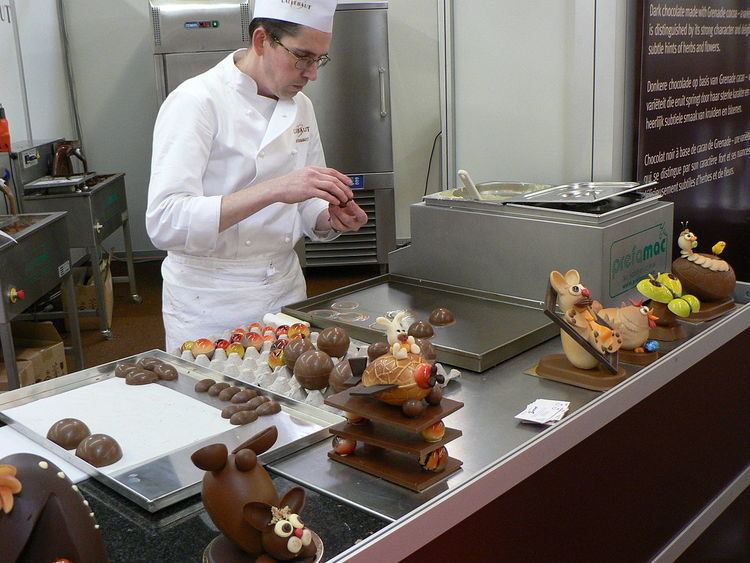 | ||
A chocolatier is a person or company who makes confectionery from chocolate. Chocolatiers are distinct from chocolate makers, who create chocolate from cacao beans and other ingredients.
Contents
Professional chocolatiers study topics including:
A comprehensive course also covers:
Education and training
Chocolatiers generally start out as pastry or confectionery chefs. Being a master chocolatier involves perfecting the art of working with chocolate to create not only delicious desserts, but also beautifully and skillfully crafted pieces of art with the chocolate. Generally it takes years of experience and a good background of confections and pastries to master the art of working with chocolate.
There are a variety of culinary schools and even specialty chocolate schools, such as the Ecole Chocolate school in Canada, and The Chocolate Academy, with twelve schools worldwide. The French Culinary Institute also offers pastry and confectionery courses that are said to help a chocolatier learn the trade.
To become a chocolatier one must learn how to make and work with chocolate on different levels to create handcrafted pieces of art that also must taste sensational. Generally schooling consists of learning how to make chocolate from a variety of different origins. Once students learn how to make chocolate and begin to understand the physical and chemical aspects of chocolates they can learn to work with chocolate in many different applications. Chocolate is a versatile food thus different courses offer learning about different techniques when working with chocolate. Once someone becomes well-educated about all of chocolates' applications, or specializes in specific applications of chocolate they may be considered a chocolatier. Often perfecting technical techniques of design and the art of flavor takes many years of practice. Advanced studies can lead to a better understanding of the components of chocolate and how to make chocolates along with sculpting and creating beautiful masterpieces from chocolate.
Competitions
Once a chocolatier has mastered the artistry of chocolate they may be considered a Master Chocolatier. The best of the best can be found competing in The World Chocolate Masters, a chocolate competition that started in 2005. Some of the greatest chocolatiers of today are Naomi Mizuno from Japan, Francisco Torreblanca, master Spanish chocolatier, Pierre Marcolini, Yvonnick Le Maux from France, and Carmelo Sciampagna from Italy. These master chocolatiers are some of the best in the world when it comes to designing and sculpting using chocolate. These master chocolatiers also craft pieces of chocolate with outstanding flavor and texture, said to be the best in the world by some. Chocolatiers must be able to work with chocolate in many different applications tempering, molding, sculpting, and decorating. Chocolate can be made into pieces, incorporated into pastries, or simply designed as a piece of art.
2007 World Chocolate Masters Winner: Naomi Mizuno Mizuno, from Japan, took home the title to the World Chocolate Masters competition in 2007. The competition was judged in four different categories, including: molded pralines, hand-dipped pralines, gastronomic chocolate dessert, small chocolate showpiece, and creative chocolate showpiece. Mizuno, 28 years old, was the youngest competitor ever from his nation. He is employed at a pastry school, Futaba Pastry.
Techniques
Tempering: Tempering chocolate is a heat treatment method performed on chocolate involving heating and cooling the chocolate to result in desired characteristics like shininess of the chocolate or 'snap', the way it breaks. A chocolatier must know how to temper chocolate properly for different applications or temper for chocolate for desired characteristics. Chocolate contains cocoa butter which crystallizes during the heat treatment of melting and tempering chocolate. The crystal formation in chocolate can affect many different attributes to the chocolate - mouthfeel, snap of the chocolate, the color, dull or shiny. Heating the chocolate at certain temperatures, around 86-90 °F (30-32 °C), for specific periods of time and then cooling the chocolate and working with, in alternating segments is referred to as tempering. There are machines that can temper chocolate for you, but many chocolatiers use marble slabs and hand-tools to cool the chocolate and work with it.
Molding: Molding is a design technique used in making chocolate pieces that are of a certain shape by taking liquid chocolate and pouring it into a mold and letting it harden. You can go to the wikiHow - Mold Chocolate Candy site to see instructions on how to mold chocolate.
Sculpting: Sculpting is a type of three-dimensional artwork, and in the case of a chocolatier, involves using only chocolate to create the piece of artwork. Sculpting may involve using molds and pieces of chocolate, and decorating the piece with designs in chocolate.
Chocolatiers in France
The presence of the chocolatier in France is significant because they embody the French gastronomic identity of being artisanal, aesthetic in addition to following high standards of taste, production and craft. The stores of French chocolatiers are small boutique stores that create aesthetically outstanding and high quality chocolate. French chocolatiers were threatened when mass-produced Belgian chocolates entered the French market in the 1980s. Because Belgian chocolates were sold in stores that emulated these French boutiques, but cost less, Belgian chocolate did very well in France at this time. French chocolatiers, artisanal chocolate makers, were upset by the lower quality, sweeter chocolate from Belgium, which brought to question of what was authentic and in-authentic chocolate. Ultimately, the French set their standard of authenticity by defining authentic chocolate as being esoterically handcrafted. Chocolatiers in France are ultimately emblems of respectable craftsmen who follow French cuisine’s reputation of higher quality, freshness, aesthetic and taste.
